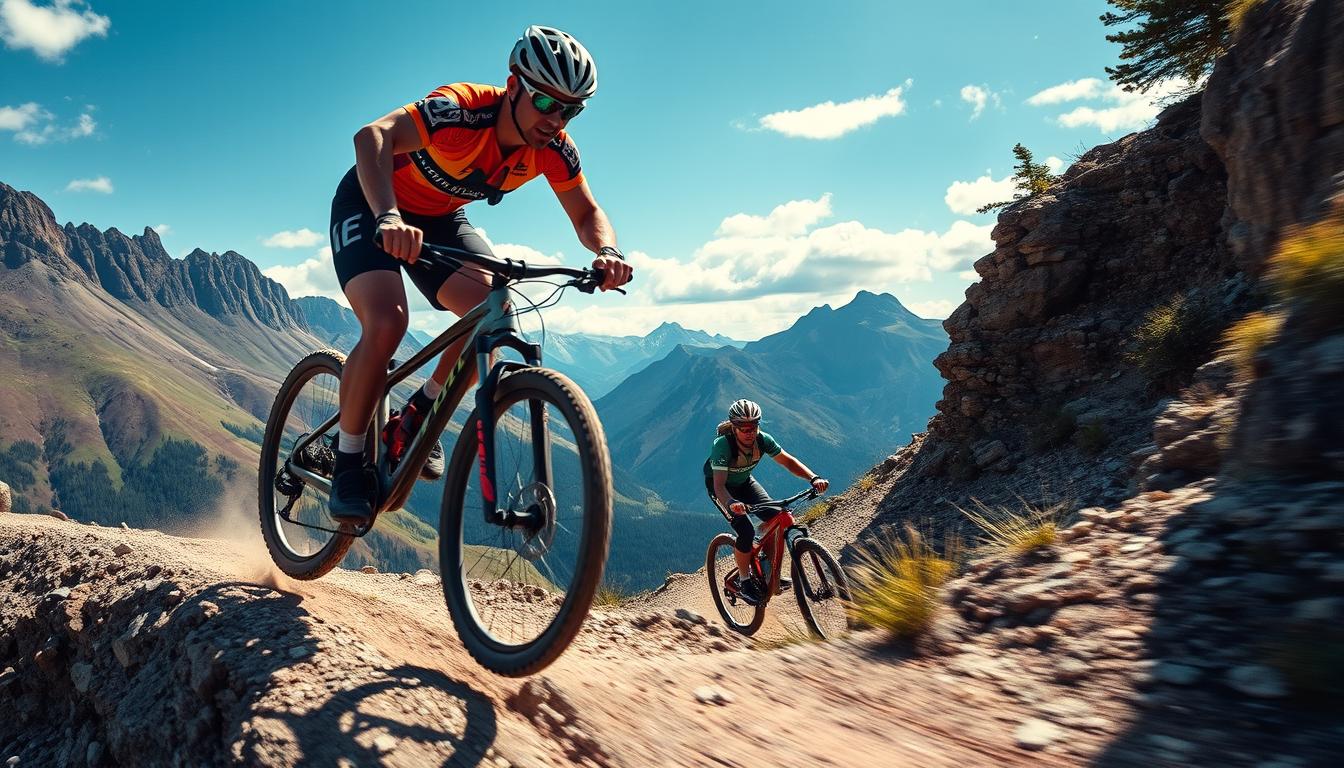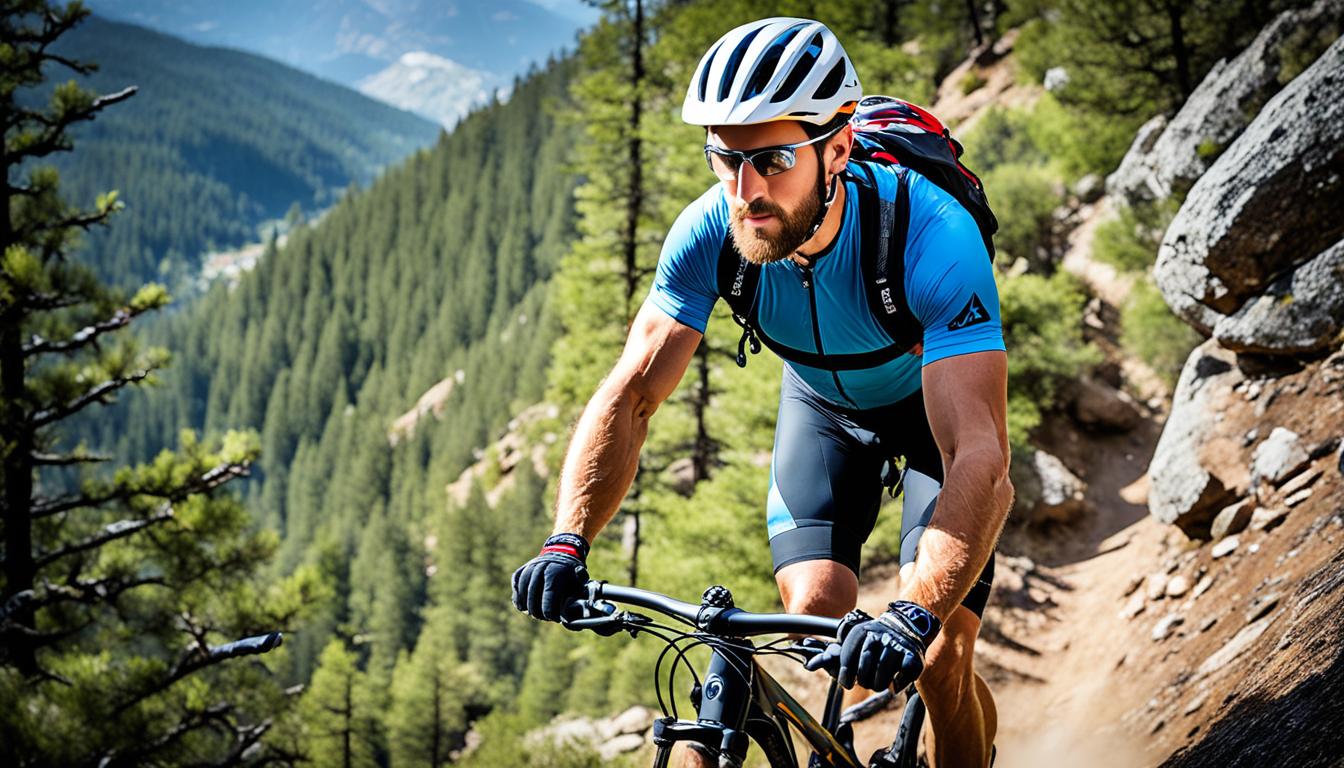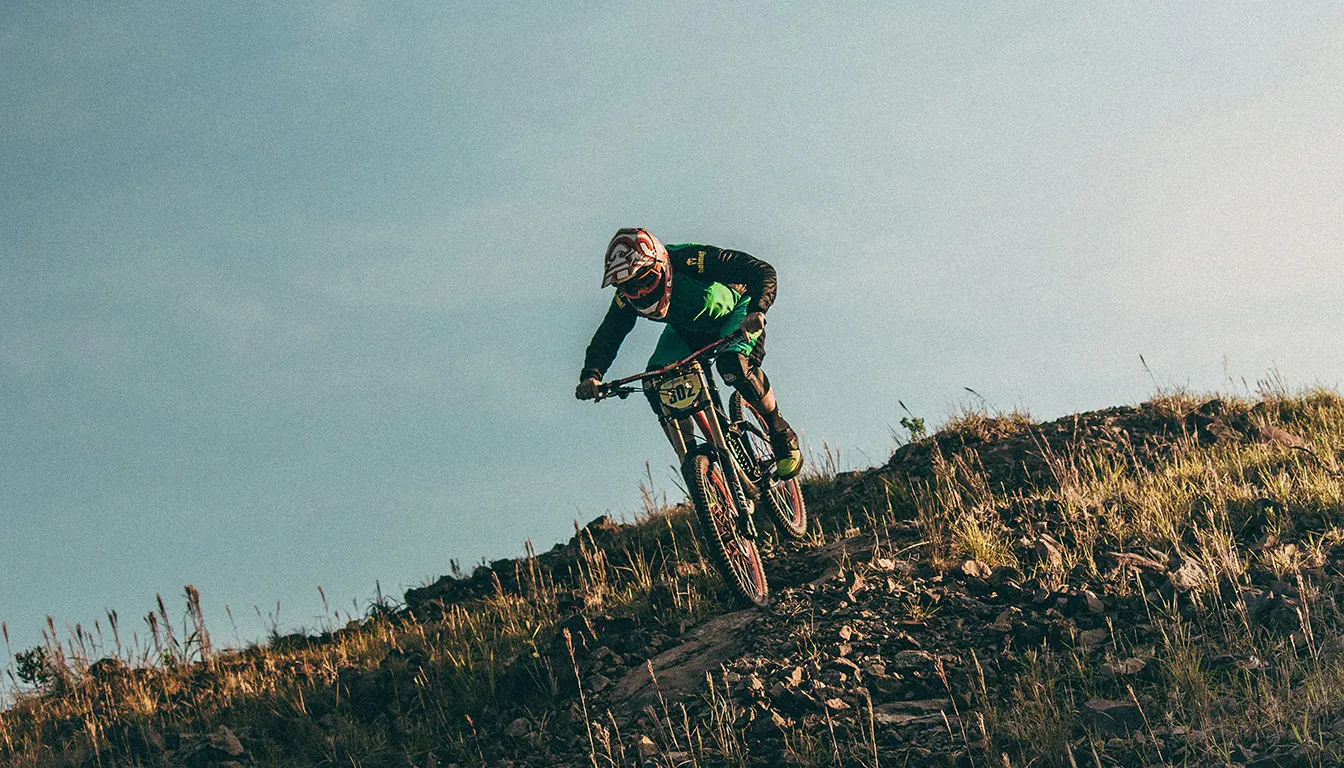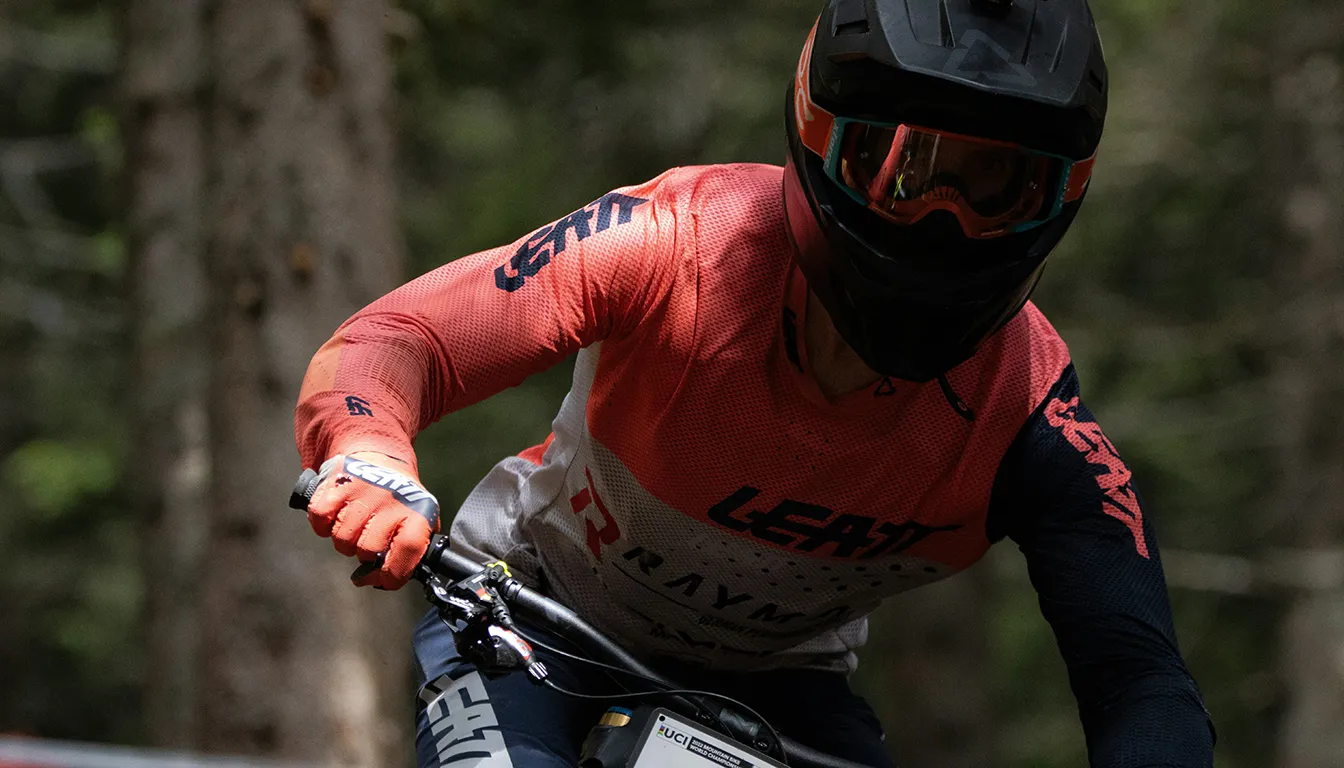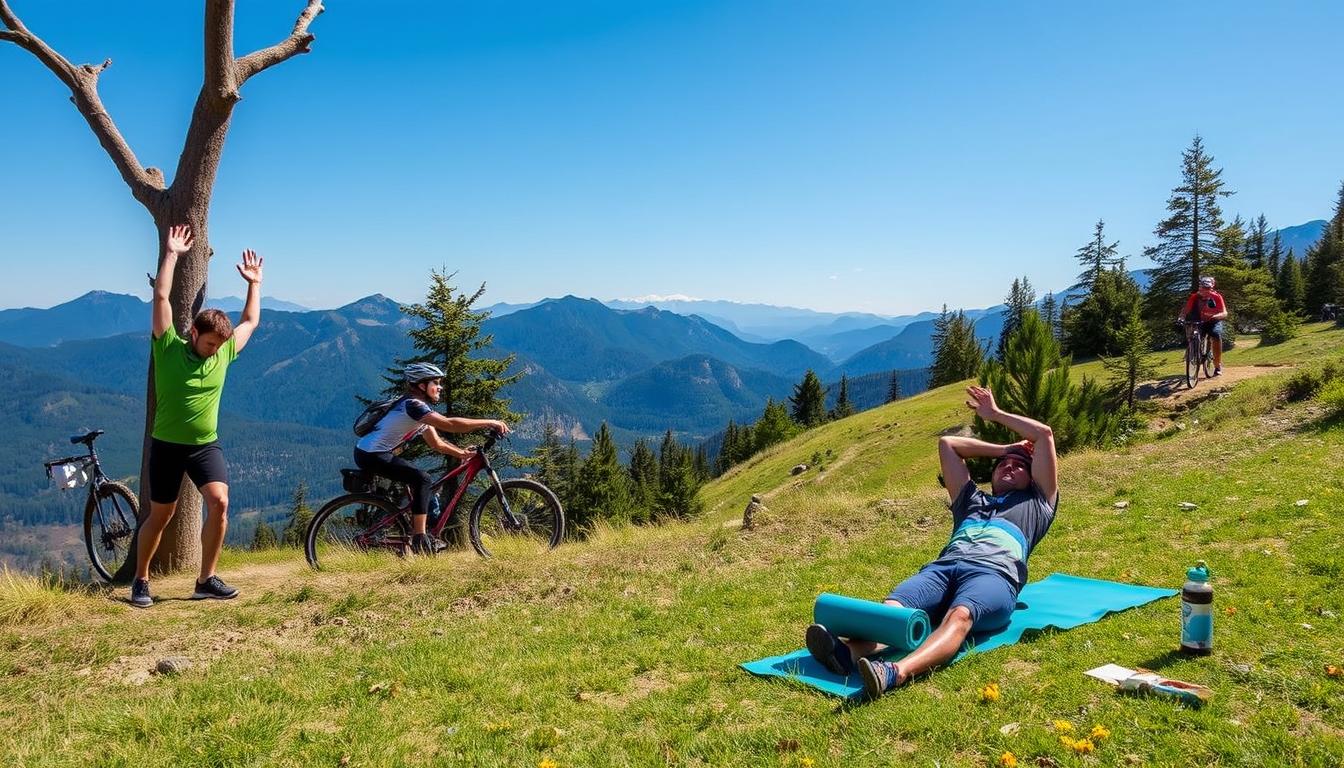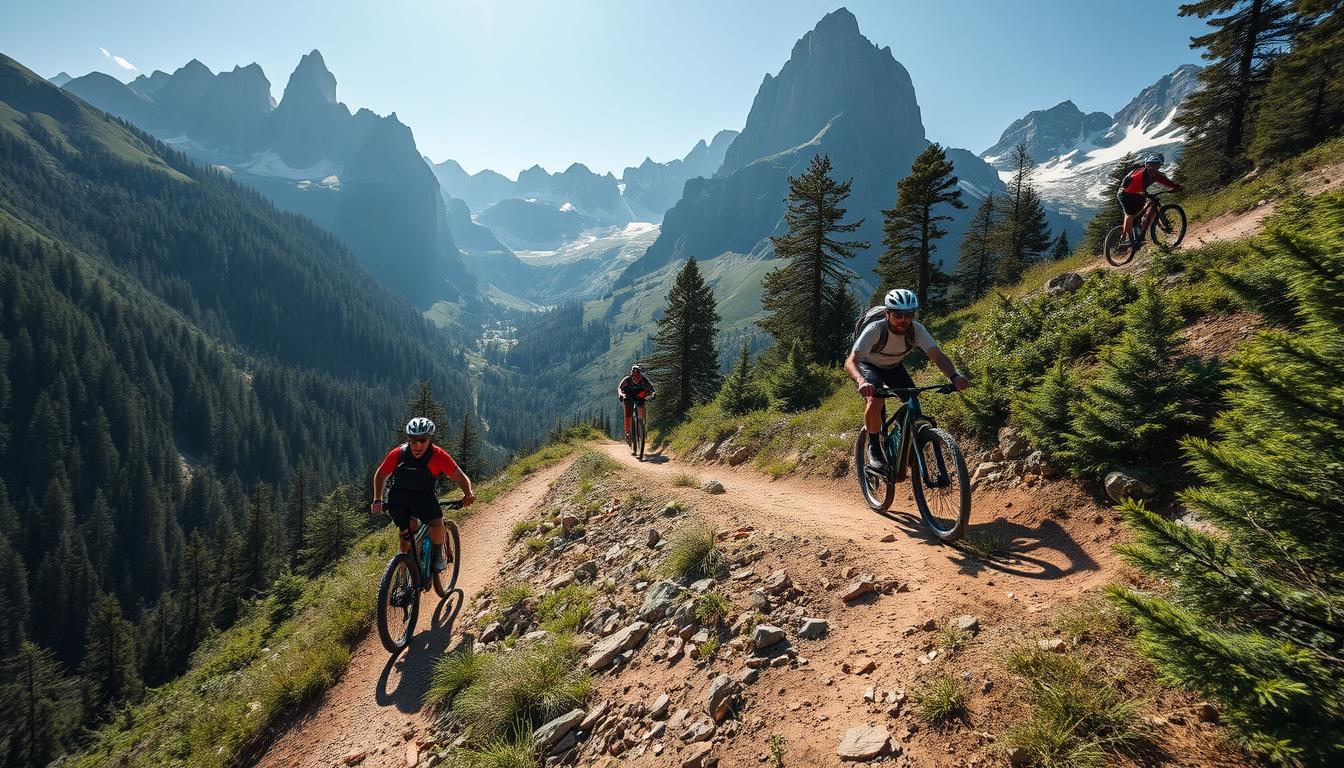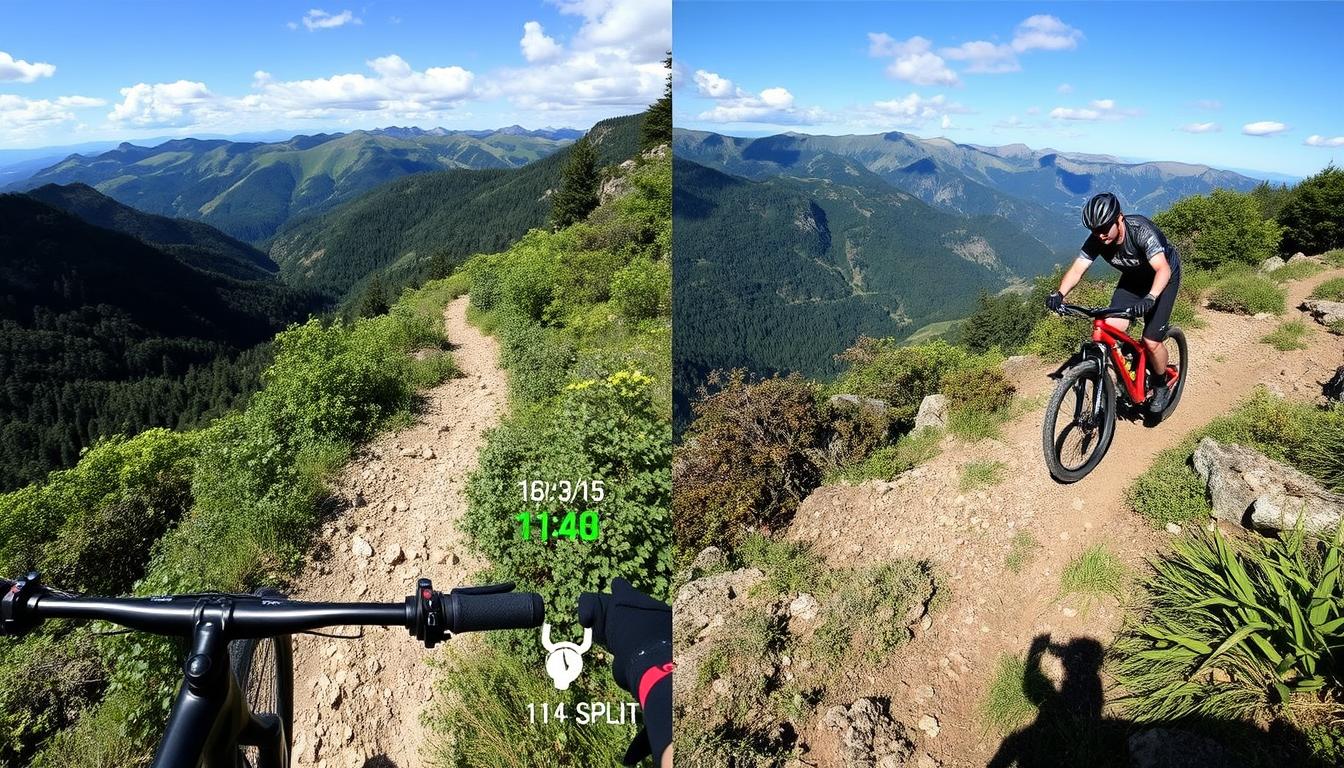Mountain biking thrives on power and explosive strength. These skills boost your ride. It’s vital to add strength training to your routine. This not only builds power and explosive force but also betters endurance and balance through tough trails.
If you bike competitively or just for fun, pick workouts that suit your ride and aims. Pros in the sport emphasise strength training’s role. For instance, Kate Courtney turned her home into a gym to focus on explosive strength training.
To excel, tailor your training and include exercises like walking lunges and deadlifts. They build the right muscles for biking success. Learn how to create the perfect fitness plan for your goals here.
Understanding the Importance of Strength Training for Mountain Biking
Strength training is key for improving mountain biking skills. By doing intense strength exercises, riders gain several benefits. These include better endurance, more power, and improved cycling efficiency.
The Benefits of Strength Training
The advantages of strength training are many. It helps by:
- Increasing bone density, which lowers fracture risks.
- Improving joint health, thus preventing injuries.
- Boosting overall strength, important for going up hills and rough paths.
- Balancing muscle groups, crucial for cyclists to avoid overworking some muscles.
- Raising metabolic rate, which helps in managing energy better during rides.
Many mountain bikers spend about three days a week on strength workouts in-season. They believe these sessions are crucial to enhance trail performance.
Pro Riders and Strength Training
Top mountain bikers take their training seriously. For example, champions like Nino Schurter and Kate Courtney include strength training in their routines. They know that gym time greatly impacts their competition results.
Around 55% of competitive mountain bikers do strength training. This shows that both professionals and amateurs benefit from including it in their routines. Such training is key for achieving success.
Key Muscle Groups for Mountain Biking
Mountain biking uses many muscle groups to be efficient and perform well. Knowing which muscles are involved is key for cyclists who want to get stronger and last longer on trails. We will explore important muscles in the lower and upper body, and how core strength helps a cyclist.
Lower Body Muscles
Lower body strength is big for mountain biking, as it drives the pedalling. The key muscles are the quadriceps, hamstrings, glutes, and calves. Quadriceps are the main muscle for power during pedalling. The hamstrings and glutes help with strength and endurance. Exercises like squats and deadlifts can make these muscles stronger and keep injuries at bay, like knee issues from weak glutes. A focused strength training plan is good for building up muscles key for mountain biking and boosting your performance.
Upper Body and Core Muscles
While the lower body powers cycling, upper body strength is crucial for balance and control. Important muscles include the triceps, lats, and pectorals for better bike handling. Core training also matters, honing in on abdominals and erector spinae for essential stability. This helps cyclists stay upright and balanced during rides. These muscles are vital for a cyclist’s strength training. To better understand muscle use in different cycling forms, see this useful guide on muscle groups mountain biking.
How to Increase Power for Mountain Biking
To get better at mountain biking, riders need to focus on power and quickness. Strength exercises build muscle and make cycling smoother. Adding explosive training helps your body face mountain biking’s tough spots.
Effective Strength Training Exercises
Choosing the right strength exercises can make you much stronger on your bike. Here’s what you should try:
- Deadlifts: These boost your core and back, making your pedalling more powerful.
- Push-ups: They build upper body strength, which helps with bike control.
- Lunges: Lunges make your legs stronger and your movements more bike-like.
Getting good at the Row and Anti-Row will better your braking skills. Keeping your knees in the right place helps with pushing off and staying balanced. Staying balanced helps you control the bike better.
Incorporating Explosive Movements
Explosive training is key for doing better in mountain biking. Jumping exercises like lunges or box jumps make you quicker. They help with fast starts, power boosts in races, and climbing steep parts.
Short sprints of 60 to 90 seconds are also good. They improve your endurance and strength. Working up to twelve sprints in one session increases your power. Block training, which mixes intense exercise and rest, helps your body get stronger. This way, you’ll keep going strong even on hard parts of the trail.
Developing a Balanced Training Routine
Creating a balanced training routine is key to getting better at mountain biking. This mix of strength and endurance exercises meets the needs of the sport. It helps riders gain both power and stamina. A good plan involves structured strength training that covers all main muscle groups. It also includes rest time for ongoing improvement.
Creating a Strength Training Schedule
For effective strength training, plan 3-5 gym sessions each week. This schedule allows for muscle building and time for weekend rides. Take Rider A’s example: gym workouts early in the week get muscles ready for tough weekend rides. It’s important to watch how much you train. Too much, especially after hard sessions, can cause muscle soreness.
- Plan sessions that target lower body, upper body, and core muscles.
- Allocate specific days for strength training and separate those from on-bike sessions.
- Include active recovery days to maintain training quality and prevent burnout.
Combining Endurance and Strength Workouts
Mixing endurance and strength exercises is key for the best mountain biking performance. Riders B and C could use a mix of on-bike and gym training. This could improve specific skills and strength needs. For example, Rider B could do interval training and skills work during the week, along with gym sessions.
“To increase cycling power, work on both the power phase and the recovery phase.”
This balanced approach highlights the importance of training both legs fully. Adding varied exercises like the Rear Foot Elevated Split Squat and Renegade Row is a must. Aim to include each exercise at least twice a week for the best results.
Nutrition and Recovery for Enhanced Performance
Right nutrition and recovery steps boost performance for mountain bikers. Eating right is key for top performance and for getting better after hard rides. Knowing how food affects strength training lets athletes make their plans better. This leads to stronger and more enduring athletes.
The Role of Nutrition in Strength Training
Mountain bikers need a balanced diet with both big and small nutrients. Carbs are very important for energy, especially in long rides. Foods like sweet potatoes and whole grains are best because they have fibre and nutrients.
Proteins help fix and recover muscles. They should make up 20-25% of all the calories you eat. Good protein sources are lean meats like chicken and fish, and plants like lentils. Healthy fats, from foods like avocados and nuts, give energy that lasts long. This shows how a varied diet is important.
Recovery Strategies
Recovery is key for better performance in mountain biking. Good recovery methods are:
- Stretching: Stretching after riding helps relax your muscles.
- Hydration: Drinking water helps get nutrients where they’re needed and aids in recovery.
- Rest: Your muscles need rest to fix themselves and grow.
- Sleep: Good sleep is important for muscle recovery and doing better.
Picking the right food and recovery ways for your biking style improves how well you do. Enough protein and healthy fats keep your muscles strong and give you energy. Staying hydrated is key at all times. By focusing on both food and how you recover, you can ride better and longer.
Conclusion
To improve your mountain biking skills, a well-rounded approach is key. It includes strength training, proper nutrition, and rest. Strength training and certain exercises will make you stronger and more explosive. This way, you’ll face tough trails with more confidence.
Fine-tuning your bike, mastering braking, and pedalling well increase your comfort and control. Core exercises enhance balance and prevent injuries. Setting goals and visualising success improve mental toughness. This makes your biking journey more fulfilling.
By applying these methods, you’ll see big gains in your biking skills. Remember, recovery is just as important as training. It helps you reap full benefits. To learn how to mix these strategies into your biking routine, check out this freeride mountain biking training guide.
FAQ
What is the importance of strength training for mountain biking performance?
Strength training boosts mountain biking skills significantly. It builds muscle, improves joint health, and increases bone density. These benefits help prevent injuries and improve bike control on trails.
How can I incorporate strength workouts into my cycling routine?
Create a balanced routine with upper and lower body exercises. Mix these with cycling sessions. Make sure you rest enough between these workouts for the best results.
What are some effective strength training exercises for mountain bikers?
Effective exercises include deadlifts, push-ups, lunges, and squats. They focus on essential muscles for cycling. This boosts your power and explosive strength on the trails.
Which muscles are most important for mountain biking?
The quadriceps, hamstrings, calves, and core are crucial for mountain bikers. Strong legs help with uphill rides. A sturdy core keeps you balanced.
How can I improve my explosive strength for mountain biking?
Add jumping lunges and plyometric presses to your routine. These explosive movements match mountain biking’s demands. They help improve your power on the bike.
What should my nutrition focus on for strength training?
Your diet should include enough proteins, carbs, and healthy fats. This combination aids in muscle repair, energy levels, and overall health. Don’t forget vital micronutrients for better recovery and performance.
How important is recovery after strength training for cyclists?
Recovery is key for cyclists to avoid injuries and repair muscles. Drink enough water, rest, stretch, and get quality sleep. These steps will boost your next workout’s effectiveness.
Can I combine strength training with endurance workouts?
Yes, mixing strength and endurance training is good. A balanced program improves your fitness. It also maximises your biking abilities on different terrains.
